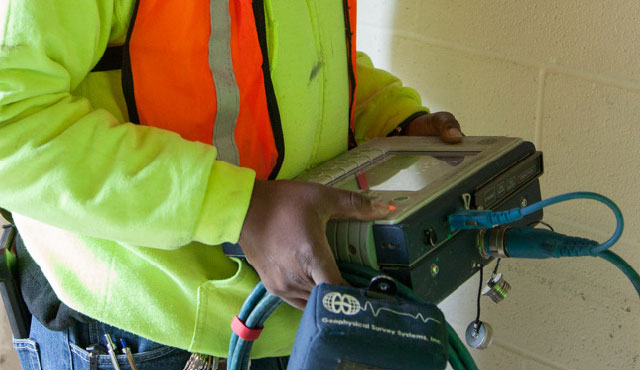Non-destructive vs. destructive testing in construction
For most people, it won’t come as a surprise that destructive testing is almost always more reliable, while non-destructive testing is nearly always more desirable.
Of course, no one wants to create holes or otherwise destroy parts of a structure during testing, but sometimes it is necessary to get reliable and complete answers.
So what’s the difference between non-destructive vs destructive testing in construction, and how do you decide?
Comparing destructive vs non-destructive testing
In order to limit damage, several methods of non-destructive testing have been developed that lessen the damage to testing materials – that doesn’t mean they are all damage free, however. It does mean repairs after non-destructive testing are usually much smaller and more manageable.
Of course, less damage – whether it’s testing concrete, masonry or other parts of the structure – is almost always preferable to owners and architects.
Particularly where aesthetics are important, non-destructive testing can often offer a solution that allows architects and owners to avoid unsightly repairs. Additionally, some methods of non-destructive testing can be cheaper because the work does not need to be torn out and redone.
By contrast, destructive testing often involves removing a piece of material that needs to be tested, such as , coring into a structure or boring into the ground to collect samples for testing in a lab.
Examples
CTL conducts several types of non-destructive testing, but below are some of the most common:
Ground penetrating radar
Ground penetrating radar, otherwise known as GPR, uses electromagnetic (EM) energy waves to image the subsurface. While it is most commonly known for locating underground utilities, it can be especially effective on concrete and masonry walls to find hollow cells, grout, and reinforcing steel . This has a wide range of uses in construction but is especially useful in understanding if concrete or masonry was installed correctly. Particularly, if an owner or architect has doubts about a mason performing his job correctly. GPR can be a great tool used for non-destructive testing
It can also help owners and architects locate what is inside the floor or walls before moving forward. For instance, GPR can be used to locate electric lines, and PT cables in concrete floors so you can penetrate the slab safely.
Although it is known for underground utilities, GPR’s usefulness can be mixed, especially in Ohio where much of the ground is made up of clay. Tiny fiber optic wires, for instance, might be difficult to find if they are buried deep where the clay is wet. The radar won’t be able to see through the moisture in the clay below a certain depth, due to EM energy attenuation.
Windsor Probes and Windsor Pins
Windsor probes are used to measure the strength of concrete on-site. Rather than the traditional (destructive) method of taking 4 inch cores of concrete back to a lab to measure its strength. Windsor probes make much smaller holes and are still able to measure compressive strength on-site.
In addition to measuring the strength of concrete, Windsor pins are often used to measure the compressive strength of mortar, particularly if a contractor is trying to determine if a new mortar matches the strength of a previous mortar.
Although the probes and pins still create small holes, they are much less noticeable than a significantly larger core sample and easier to patch and repair.
Deciding what type of testing is right for you
So how do you decide if destructive or non-destructive testing is right for you? CTL Engineering typically recommends non-destructive testing first, whenever possible. Because it allows for testing that requires minimal, if any, repairs, most people are happier with the end result. In many cases, non-destructive testing is also often cheaper.
But there are cases where non-destructive testing isn’t able to give the results needed or, in some cases, actually finds a problem. Then, destructive testing is the next best step to gather even more information and guarantee accurate results.
Contact CTL today to find out more information about how non-destructive testing can benefit you.

